The MoneyWeek Trader 2012 trading quiz
Based on recent market action, spread betting expert John C Burford offers his 2012 Christmas trading quiz, and suggests a New Year's resolution for traders.
This is my last post for 2012 and in keeping with tradition, I am offering a 2012 trading quiz for the holidays, which is based on very recent market action.
Before I start, I must mention the staggering overnight collapse in several markets gold already being in its own and that somewhat changes my quiz that I had prepared yesterday!
The Dow was down over 300 points at one point, but it does highlight the correct Elliott wave interpretation I already had on the worked example (scroll down tosee my first chart). And it vividly highlights the extreme usefulness of using EW theory at major turning points. Thank you, Ralph Elliott and it proves it is well worth the effort to understand his ideas!
MoneyWeek
Subscribe to MoneyWeek today and get your first six magazine issues absolutely FREE

Sign up to Money Morning
Don't miss the latest investment and personal finances news, market analysis, plus money-saving tips with our free twice-daily newsletter
Don't miss the latest investment and personal finances news, market analysis, plus money-saving tips with our free twice-daily newsletter
This year, I have written around 150 posts, all concerned with showing how I analyse markets using my tramline, Fibonacci and Elliott wave methods using real-time examples. I know from the emails I receive that my writings have transformed the trading performance of many readers. That is extremely pleasing to me, and that is truly the main reason I offer these Trader posts.
I hope to continue this work in 2013, and if you can glean just one useful concept here, I consider that a major success.
The most important lesson of all
If you have been following my posts, you will have learned several important technical aspects of trading, but the most important by far is this: money management.
When I have alluded to a trade, it is always intended to be a low-risk trade.That means placing a stop loss close to the entry. Of course, this policy often leads to losing trades, but I would rather lose little than large!Because I have a flexible market attitude, I am able to promptly re-assess the situation and, if necessary, re-enter. I encourage all swing traders to adopt this approach.
One other crucial point is this: to be effective, you must reduce internal stress as much as you can. If you worry excessively, or hold market views with a pseudo-religious fervour, then your performance will suffer. You may be on the winning side for a while, but the inevitable reversal will catch you out as you fail to see the changed circumstances. I don't have to tell you that the highly emotional gold market comes to mind here.
And if you are trading in size and lose sleep, you need to reduce your positions.
The old market saw is so appropriate "reduce your positions down to the sleeping level". Remember, you are trading to make money, not to join a club of like-minded people.
Now, on to the quiz:
The 2012 trading quiz
And it is on Elliott waves. I know, many readers and workshop delegates profess a total lack of understanding of Elliott waves, and that is why my quiz concerns this most valuable method. It will be well worth your time mastering the basics, at least.
It should be clear from myposts that markets are patterned, and the zigs and zags are often part of the same patterns that repeat time and time again. You can train yourself to recognise these patterns and boost your performance.
And there are two important patterns that I am always on the lookout for. First is the five-wave motive thrust with the third wave being long and strong. This thrust can instantly be recognised as a trending market.
The fifth wave is always an ending wave and usually sports a negative momentum divergence between the third wave extreme. That is my ideal scenario.
The second pattern is my famous A-B-C, which is always a corrective move to the main trend.
And just this week we are presented with a magnificent example in the Dow of both patterns in one:
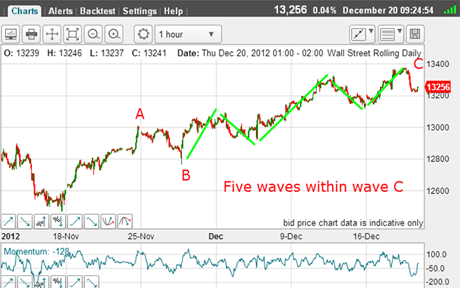
(Click on the chart for a larger version)
From the major mid-November low (see it on the daily chart), I have waves A and B, and on Wednesday, a new rally high was made for my wave C.
The EW rule is simple here:after the proposed C wave top has been made, the bear market can resume.
So what tells me that we have made the wave C top at 13,375?
For that, we take apart the C wave and see that there is a clear five-wave pattern marked by my green lines. Wave 3 is long and strong, and wave 4 does not overlap wave 1.
That is textbook, although there is no momentum divergence on this hourly chart.The C wave (also a third wave!) is long and strong. This C wave is now complete and the decline off the 2007 top can now resume.
This means I have good evidence that we have the top in place, but is there more available?
For this, I need to see a small-scale five-wave decline off this top. If I can identify that, I am home and dry for a high-probability forecast (but remember, nothing in forecasting is 100% certain, and that is why stop loss orders were invented).
The quiz therefore consists in finding five-wave declines off this week's highs in various markets (you can add your own if you wish). And note that this analysis is a fiscal cliff-free zone.
If you can find these five-wave moves, then go ahead and trace out a likely scenario retracement patterns and likely turning points.
Also as part of the exercise: try to identify low-risk entry points.
Note: These charts were taken yesterday and there has been much development since then!
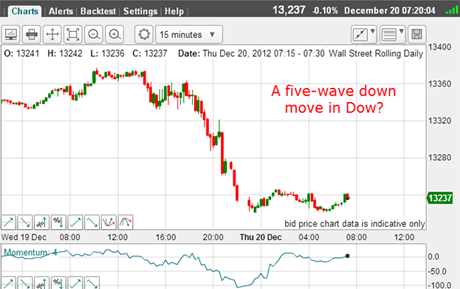
(Click on the chart for a larger version)
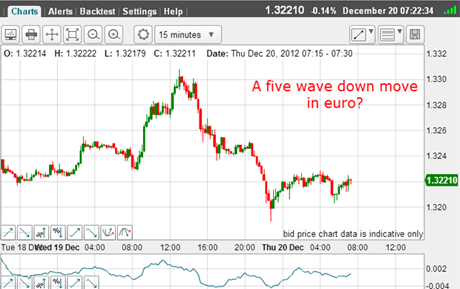
(Click on the chart for a larger version)
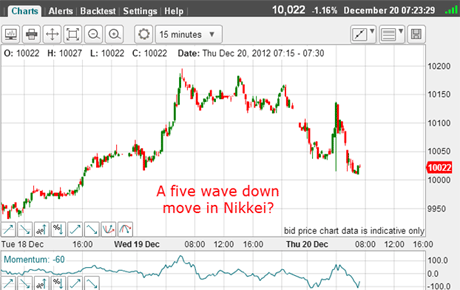
(Click on the chart for a larger version)

(Click on the chart for a larger version)
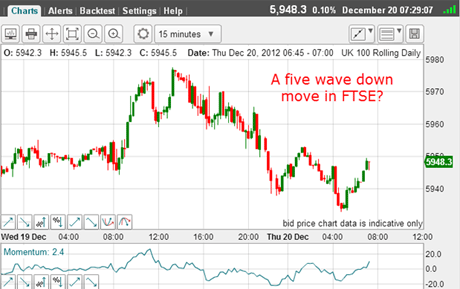
(Click on the chart for a larger version)
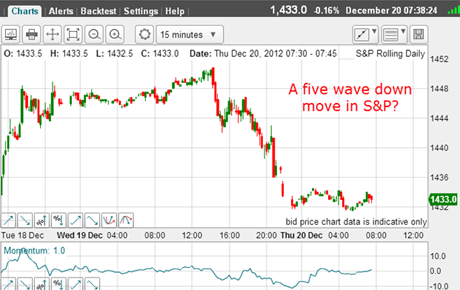
(Click on the chart for a larger version)
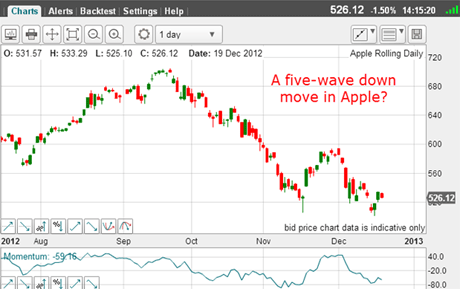
(Click on the chart for a larger version)
The idea is to identify the waves and put the labels on your chart. Remember, you can use the first chart in the Dow as an example of what to look for.
And finally...
A suggestion for your New Year's resolution
"I resolve to exercise strict discipline in the money management of all of my trades, and vow to never let a single loss on any tradeexceed my rule by always entering stop loss orders when I enter each trade. I refuse to wing it!
"I also vow to search for the very best trades and to be more selective in my choice and to analyse the markets objectively."
As a wise trader said to me once: "John, if Santa gave me the choice between a great trading system with a mediocre money management rule, or a mediocre system with a rock solid money management rule, I would go for the latter every time".
Wishing all my readers a safe and Happy Christmas and a prosperous New Year!
If you're a new reader, or need a reminder about some of the methods I refer to in my trades, then do have a look at my introductory videos:
The essentials of tramline trading
An introduction to Elliott wave theory
Advanced trading with Elliott waves
Don't miss my next trading insight. To receive all my spread betting blog posts by email, as soon as I've written them, just sign up here . If you have any queries regarding MoneyWeek Trader, please contact us here.
Get the latest financial news, insights and expert analysis from our award-winning MoneyWeek team, to help you understand what really matters when it comes to your finances.
John is is a British-born lapsed PhD physicist, who previously worked for Nasa on the Mars exploration team. He is a former commodity trading advisor with the US Commodities Futures Trading Commission, and worked in a boutique futures house in California in the 1980s.
He was a partner in one of the first futures newsletter advisory services, based in Washington DC, specialising in pork bellies and currencies. John is primarily a chart-reading trader, having cut his trading teeth in the days before PCs.
As well as his work in the financial world, he has launched, run and sold several 'real' businesses producing 'real' products.
-
 The graphene revolution is progressing slowly but surely
The graphene revolution is progressing slowly but surelyEnthusiasts thought the discovery that graphene, a form of carbon, could be extracted from graphite would change the world. They might've been early, not wrong.
-
 How Javier Milei led an economic revolution in Argentina
How Javier Milei led an economic revolution in ArgentinaFollowing several setbacks, Argentine president Javier Milei's pro-market reforms have been widely endorsed in a national poll. Britain will need the same